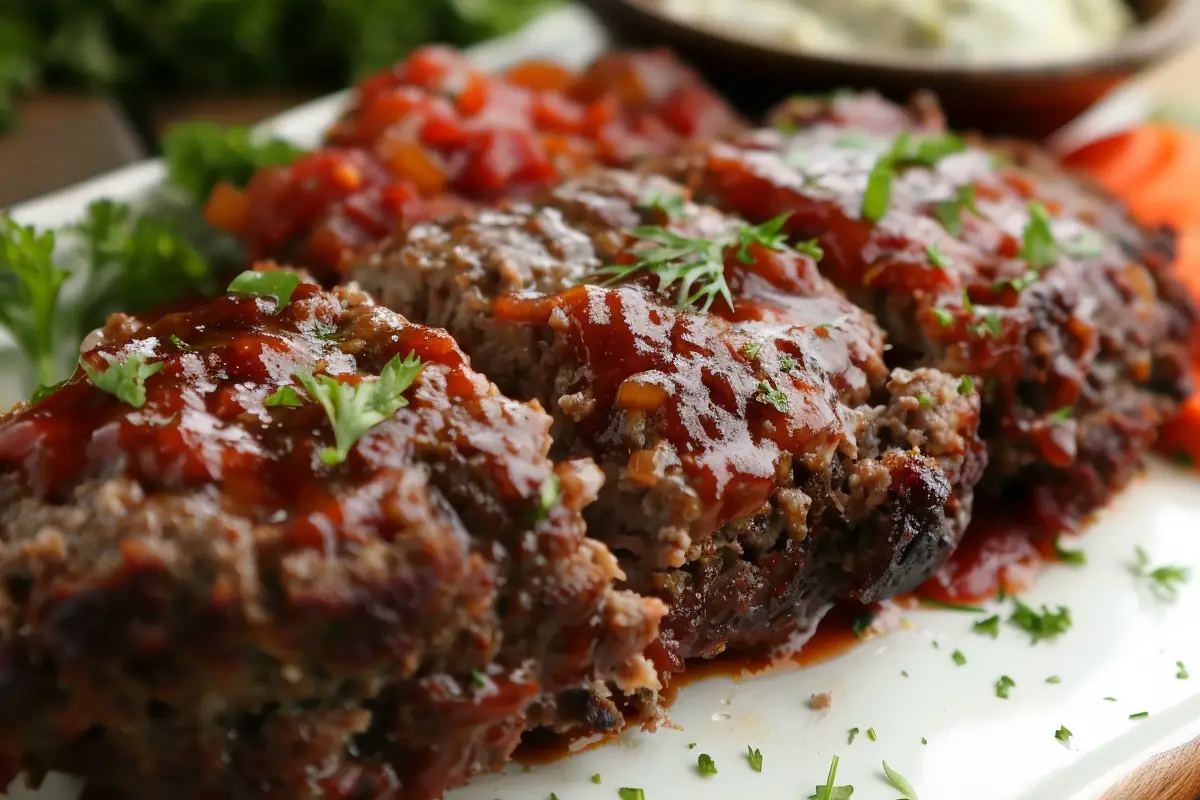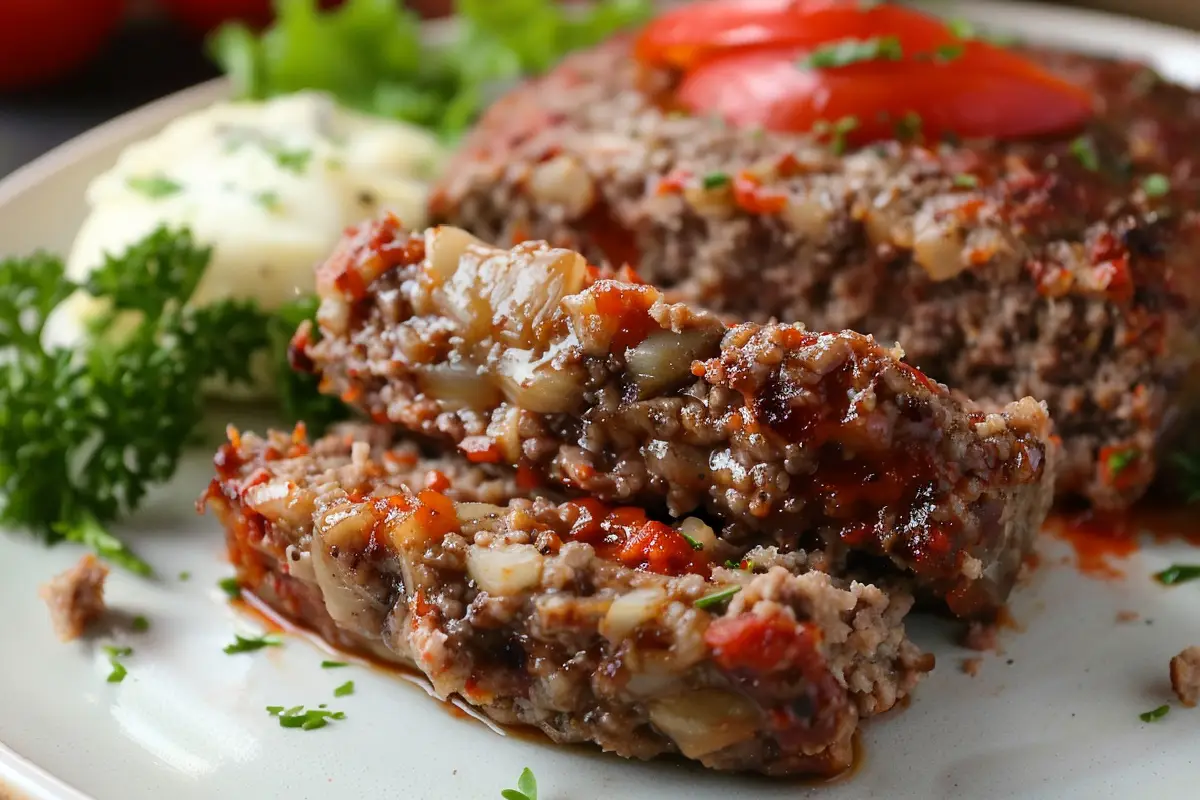Introduction to Covered vs. Uncovered Meatloaf
For a unique twist, you can also explore our Smoked Meatloaf Recipe. This recipe shows how different cooking techniques can enhance the flavor and texture of your meatloaf.
What is Meatloaf?
Meatloaf is a classic comfort food that has been enjoyed in many cultures for generations. At its core, meatloaf is made from ground meat, usually beef, combined with a mix of other ingredients such as breadcrumbs, eggs, onions, and various seasonings. These ingredients are blended together, shaped into a loaf, and baked until cooked through. The combination of meat and binders creates a dense yet tender dish that holds its shape, making it perfect for slicing and serving. Meatloaf is highly versatile; it can be adapted with different meats, such as pork, turkey, or chicken, and can be customized with herbs, spices, and vegetables to suit individual tastes and dietary needs.
This dish’s appeal lies not only in its simplicity but also in its adaptability. Meatloaf can be topped with a variety of sauces or glazes, such as ketchup, barbecue sauce, or a sweet mustard glaze, which adds extra layers of flavor. These toppings can either caramelize beautifully when baked uncovered, creating a sticky and flavorful crust, or stay soft and juicy when cooked covered, adding moisture to the loaf. Meatloaf is often seen as a comforting meal, perfect for family dinners, meal prepping, or even as leftovers the next day in sandwiches. Its ability to be customized, combined with its rich, hearty flavor, makes meatloaf a staple in many households, embodying the essence of home-cooked comfort food.
Common Ingredients in Meatloaf

Most meatloaf recipes include the following ingredients:
- Ground meat: Beef is the most common choice, but pork, turkey, or chicken can also be used.
- Breadcrumbs or oats: These help bind the ingredients and hold the loaf together.
- Eggs: Eggs act as a binder, keeping the meatloaf intact during cooking.
- Onions and garlic: These aromatics add depth and enhance flavor.
- Seasonings: Common seasonings include salt, pepper, Worcestershire sauce, and herbs like parsley or thyme.
- Toppings: Ketchup, barbecue sauce, or a mustard glaze adds a tangy, sweet layer to the meatloaf.
These ingredients affect the meatloaf’s overall texture and moisture, making the cooking method—covered or uncovered—a key factor in the final result.
Why Does Cooking Method Matter?
Deciding whether to cook your meatloaf covered or uncovered can change the outcome of your dish in several ways:
- Moisture Retention: Covering traps steam inside, which helps keep the meatloaf moist.
- Browning and Texture: Cooking uncovered allows the top to brown, adding a crispy texture.
- Cooking Time: Covered meatloaf often cooks faster due to the trapped heat and steam.
Understanding these effects helps you choose the best cooking method based on your preferences and recipe requirements.
Cooking Meatloaf Covered: Pros and Cons
Cooking meatloaf covered involves wrapping it in aluminum foil or using a baking dish with a lid. This method traps steam, affecting how the meatloaf cooks.
Pros:
- Keeps Meat Moist: Covering locks in steam, preventing the meatloaf from drying out, especially when using lean meats like turkey or chicken.
- Even Cooking: The steam helps cook the meatloaf evenly, avoiding an overcooked exterior with an undercooked center.
- Prevents Burning: Covering prevents the top from browning too quickly, which is helpful for recipes that use sweet glazes that might burn.
- Less Mess: Covering reduces splattering, keeping your oven cleaner and making cleanup easier.
Cons:
- Soft Top: A covered meatloaf won’t develop the same crispy, browned crust that uncovered cooking provides.
- Less Flavor Development: Without direct heat, the top may lack the rich flavors created by browning and caramelization.
When to Cook Meatloaf Covered
Cook your meatloaf covered in situations where retaining moisture is important:
- Using Lean Meats: Covering helps keep lean meats like turkey and chicken moist.
- Preventing a Mess: Covering contains splatters and keeps your oven cleaner.
- Long Cooking Times: Covering helps protect the top from burning during extended baking.
Tips:
- Cover the meatloaf with foil during the first 30-40 minutes of baking to retain moisture.
- Uncover during the last 15-20 minutes to allow some browning and improve flavor.
Cooking Meatloaf Uncovered: Pros and Cons
Cooking your meatloaf uncovered exposes it to direct oven heat, allowing the top to brown and develop a crispy crust. This method enhances the flavor and texture, making the meatloaf more appealing.
Pros:
- Crispy, Caramelized Top: Direct heat creates a browned, crispy crust, adding texture and enhancing flavor.
- Better Glaze: If you use a glaze, cooking uncovered allows it to thicken and caramelize, creating a sticky, flavorful topping.
- Enhanced Flavor: The Maillard reaction, which occurs when proteins and sugars cook under high heat, adds depth and complexity to the meatloaf.
Cons:
- Drying Risk: Without a cover, the meatloaf is more likely to dry out, especially around the edges.
- Uneven Cooking: The outside may cook faster than the center, leading to an overcooked crust and an undercooked interior.
When to Cook Meatloaf Uncovered
Cooking uncovered works best when you want a browned, crispy top or when using a glaze that benefits from direct heat exposure.
Tips:
- Bake uncovered to achieve a crispy crust and allow the glaze to set.
- Use a meat thermometer to ensure the internal temperature reaches 160°F (71°C) to avoid undercooking while preventing dryness.
Expert Tips on Balancing Covered and Uncovered Cooking
For the best results, many chefs recommend a combined approach: start by cooking your meatloaf covered and finish it uncovered. This hybrid method allows you to enjoy the benefits of both techniques—moisture retention and flavor enhancement.
Step-by-Step Guide:
- Cover to Start: Cover the meatloaf with foil or a lid for the first 30-40 minutes. This helps it cook evenly and stay moist.
- Uncover to Finish: Remove the cover for the final 15-20 minutes. This allows the top to brown and any glaze to set, adding flavor and texture.
- Check Temperature: Use a meat thermometer to ensure the internal temperature reaches 160°F (71°C) for safe consumption.
This combined approach provides a juicy, tender meatloaf with a satisfying, crispy top.
Common Mistakes When Cooking Meatloaf
Even with a great recipe, common mistakes can lead to disappointing results. Here’s what to avoid to ensure your meatloaf turns out perfectly:
- Overcooking or Undercooking: Overcooked meatloaf will be dry, while undercooked meatloaf can be unsafe. Use a meat thermometer to ensure it reaches 160°F (71°C).
- Incorrect Oven Temperature: Baking at too high a temperature can burn the outside before the center cooks. A steady 350°F (175°C) is ideal for most meatloaf recipes.
- Skipping Rest Time: Let the meatloaf rest for about 10 minutes after baking. This helps the juices redistribute, making each slice more flavorful and easier to cut.
Serving Suggestions and Recipe Variations
Pair your meatloaf with delicious sides and explore different variations to keep things exciting.
Sides to Serve with Meatloaf
- Cheesy Mashed Potatoes: Rich and creamy, these potatoes perfectly complement the savory flavors of meatloaf.
- Roasted Vegetables: A mix of carrots, potatoes, and Brussels sprouts adds a healthy, colorful touch to your plate.
- Buttered Green Beans: Fresh green beans sautéed with butter and garlic offer a crisp, light contrast to the hearty meatloaf.
Meatloaf Variations
- Smoked Meatloaf: Adding a smoky flavor elevates the traditional dish to a new level. Try our Smoked Meatloaf Recipe for a unique twist.
- Italian-Style Meatloaf: Incorporate Italian sausage, parmesan cheese, and marinara sauce to give your meatloaf an Italian twist.
- Veggie-Packed Meatloaf: Add finely chopped vegetables like carrots, bell peppers, and zucchini for extra moisture and nutrients.
FAQs about Covered vs. Uncovered Meatloaf

How long should meatloaf be cooked?
A 2-pound meatloaf should bake at 350°F for about an hour. Always use a thermometer to check that the internal temperature reaches 160°F.
Do you put water in the pan when cooking meatloaf?
Adding water or broth to the pan can help keep the meatloaf moist, especially when cooking uncovered. This extra moisture prevents the meat from drying out.
How can you tell when meatloaf is done?
The most reliable method is to use an instant-read thermometer. Insert it into the center of the meatloaf; it’s done when the internal temperature reads 160°F.
Should you let meatloaf rest before serving?
Yes, letting the meatloaf rest for about 10 minutes helps the juices set, making it easier to slice and enhancing the flavor.
Final Thoughts about Covered vs. Uncovered Meatloaf
Choosing whether to cook your meatloaf covered or uncovered depends on what you want from your dish. If you prefer a moist and tender meatloaf, cooking it covered for most of the time will keep it juicy. This method traps steam and prevents the meatloaf from drying out.
If you like a crispy, browned top with deeper flavor, try cooking your meatloaf uncovered or finish it uncovered. This method allows the top to brown and adds a satisfying texture.
The key is to balance both methods to get the result you love. Start covered to keep it moist, then uncover toward the end to add crispiness. Whether you prefer the classic approach or want to try something new, like our Smoked Meatloaf Recipe, you can create a delicious, comforting meal that everyone will enjoy.

